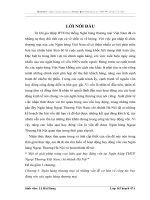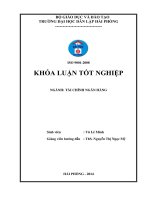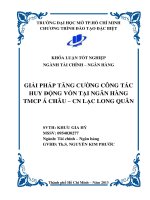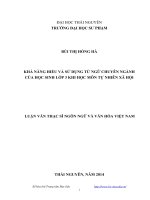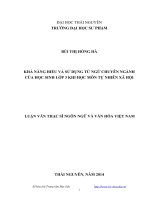Hiệu quả sử dụng smartphone về kết quả của học sinh tại trường đại học ngoại thương chi nhánh II( ANOVA )
Bạn đang xem bản rút gọn của tài liệu. Xem và tải ngay bản đầy đủ của tài liệu tại đây (198.84 KB, 23 trang )
FOREIGN TRADE UNIVERSITY
Faculty of Economics and International Business
---------------------------
DISSERTATION
THE EFFECT OF USING SMARTPHONE ON THE RESULT OF THE
STUDENT IN FOREIGN TRADE UNIVERSITY BRANCH II (ANOVA)
List of members
No
Ho Chi Minh City – April, 2014
Full Name
Student ID
1
Phạm Thị Hạnh
1201017091
2
Nguyễn Ngọc Huy
1201017131
3
Đinh Tiến Phú
1201017261
4
Trần Bích Phượng
1201017283
5
Nguyễn Ngọc Thúy Quỳnh
1201017300
6
Nguyễn Thị Bích Trâm
1201017394
TABLE OF CONTENTS
ABSTRACT
1. Introduction
1
2. Theory and research methodology
2
2.1. Theoretical basis and Analysis framework
2
2.2 Methods of data collection and model estimation technique
6
3. Results and discussion
7
3.1 Descriptive data
7
3.2 One-way ANOVA model
9
3.3 HSD (honest significant difference) test
11
4. Conclusion and Policy Implication
16
REFERENCE
18
THE EFFECT OF USING SMARTPHONE ON THE RESULT OF THE
STUDENT IN FOREIGN TRADE UNIVERSITY BRANCH II (ANOVA)
ABSTRACT
In this digitization world, media is constantly improved day by day. From the
laptop to the cell phone, especially smart phone. Using modern technology to serve for
the purpose of learning is really a powerful tool. However, beside the good side, it still
has some downsides surround the use of phone. Almost the students use smart phone
more than 2 hours each day. Spending too much time using phone may be the reason
makes students’score feel lack of concentration, lacking of sleeping or even though it
can make student live in digital world and live far away from people around them. So
how about student of Foreign Trade University II? Using smart phone too much make
effect on learning outcomes? Isn’t it? Thus, our group researched, reviewed and
analyzed the relationship between the time using smart phone of student at FTU2 in
Ho Chi Minh City and their learning outcomes. Purposes of researching is
understanding clearly the degree of influence of time using smart phone to the result of
learning and review that if spending lots of times on using smart phone, Will they
really effect to your learning outcomes? If yes, we will show some ways to surmount
this situation. Through the using of factor ANOVA variance methods from the direct
survey 238 students, we have a conclusion that using smart phone too much can effect
to student’s results. Finally, our group will expose some ways to restrict using smart
phone excessively and how to use efficiently to promote the learning outcomes of each
student.
KEY WORDS: Learning outcome, time of using, analysis of variance, Foreign Trade
University 2, students, one-way ANOVA, Tukey's HSD test
Smartphone Effective
Page 4
1. Introduction
Nowadays, along with the evolution of Information Technology, telephones are
not only for texting and calling purposes, but they also help us to connect with each
other via social networks, email and other online services... These smartphones are
becoming more modern and helpful day after day. However, overusing smartphone
may cause many negative effects on everyone especially college students. These
effects include decline in health, waste of time and decrease in study result... The
decrease in study result is the most serious consequence when smartphones are getting
commoner among the students.
The phenomenon that smartphones are addictive and affect many respects of
life is no new problem. It has appeared so many times on the media. This is an
unsolvable problem for the students as well as a deep concern for the parents.
Therefore we decide to carry on the topic “The effect of smartphone on the study
result of the student in Foreign Trade University branch II” by analyzing One - factor
ANOVA. We find down how the percentage, scale and usage of smartphone of the
second-year student of Foreign Trade University branch II in HCMC change their
study result as well as propose some solution to overcome this worrying problem.
2. Theory and research methodology
2.1. Theoretical basis and Analysis framework
While the analysis of variance succeeded in the 20th century, antecedents
extend centuries into the past according to Stigler. These include hypothesis testing,
the partitioning of sums of squares, experimental techniques and the additive model.
Laplace was performing hypothesis testing in the 1770s. The development of leastsquares methods by Laplace and Gauss circa 1800 provided an improved method of
squares. By 1827, Laplace was using least squares methods to address ANOVA
problems regarding measurements of atmospheric tides.
Smartphone Effective
Page 5
The phrase “analysis of variance” was coined by Sir Ronald Aylmer Fisher, a
statistician of the twentieth century, who defined it as “the separation of variance
ascribable to one group of causes from the variance ascribable to the other groups.
Tests hypotheses are made about differences between two or more means. If
independent estimates of variance can be obtained from the data, ANOVA compares
the means of different groups by analyzing comparisons of variance estimates. There
are two models for ANOVA, the fixed effects model, and the random effects model (in
the latter, the treatments are not fixed).
The purpose of analysis of variance is to see if there is any difference between
groups on some variable. In research, analysis of variance is used as a way to consider
the effect of a cause factor to the results factor.
The method contains:
Supposing we have k groups 1, 2, 3 …k (may be different from size). Calling
µ1,µ2,µ3….µk
Xij: observation j of group i
Group 1
Group 2
…
Group k
x
11
x
12
…
x
…
x
…
x
x
1n1
x
21
x
22
…
2n2
k1
…
k2
…
…
x
knk
Hypothesis: Ho µ1=µ2=……µk
H1: µ1differnt µ2……different µk
Step 1 :Find the average each group : =
Find the average each group:): =
Step 2 :Find total sum of squares
Smartphone Effective
Page 6
SSW- Within groups sum of squares:
SSW=SS1+SS2+…SSK=
SSG –Between group sum of squares
SSG=
Total sum of squares SST=SSW+SSG=
Step 3: Find variances
MSW (mean square within): MSW=
MSB (mean square between): MSB=
Step 4:One-way ANOVA Table
Source of SS
Df
MS
F ratio
variation
(sum
of (degrees of (mean of
square)
freedom)
square)
Between
SSB
k-1
MSB=
F=
Samples
Within
SSW
n-k
MSW=
Samples
Total
SST
n-1
In: k number of populations
N Sum of the sample size from all populations
df Degrees of freedom
HSD (honest significant difference) test
Smartphone Effective
Page 7
The purpose of the analysis of variance is to test the hypothesis H0 that the
overall average is equal. After the analysis and conclusions, there are two cases which
can occur: H0 hypothesis is accepted or rejected .If the hypothesis H0 is accepted,
analysis will end. If the hypothesis H0 is rejected, the overall average is not equal. So
the next further issue is to analyze and identify that any group is different from other
groups, the average of groups is greater or smaller.
There are many methods to calculate when hypothesis H0 is rejected. We use
Tukey method. The content of this method is to compare pairs of the average groups at
a significance level α for all possible tested pairs to detect the different groups .
Example:
Research byU.S.scientistsatKent State UniversityofOhiofound thatstudents-students
usingsmart phonetoomuchcan lead toanxietyandlearning outcomedecline. The
researcher surveyed 500 students on daily smartphone usage , lifestyle analysis and
academic scores for the purpose of considering whether smartphones can help improve
their lives or not.
The result shows that using smartphone too much has scores of disadvantage. Students
who use too much have the worst score but they are at the highest level of anxiety.
The teamreportedin the journalComputersinHumanBehaviormajors: "When the
frequency
ofmobile
phoneuseis
toohigh,
the
degree
of
successinlearning
andinlifefellcomfortable. Statistical modelingsuggests thatsuchrelationshipsareclear.
Research of Dr. Karla Murdock at Washington Lee (USA) University has the same
result. This research shows that students who send a lot of message usually less sleep
and more stress than others.
Smartphone Effective
Page 8
Based on that, we decide to use analysis of variance and Tukey's HSD test to
survey whether using smartphone affects to the study result of the second-year student
of FTU II or not.
2.2 Methods of data collection and model estimation technique
The data used in this research is collected from the researchers’ questionnaires.
Because of time and resources restriction, the researchers only carry survey on 238
people. Therefore, the result cannot generalize for the whole set because each
individual surveyed has their own features and cannot represent for the whole set.
We had to choose the one factor ANOVA to analyze. Compare the average of
many populations based on the average of models. Consider the effect of one factor
reason to result factor.
3. Results and discussion
3.1 Descriptive data
Below is the data collected from 238 people, questioned about how many hours
the sophomore of FTU II use smartphone and their study result / average mark? Base
on their using hour, we divided them into 4 groups (as shown in the table). The unit of
measure is hour.
Groups of factor
from 0h to 2h
>2h to 4h
>4h to 6h
>6h
8,88
7,20
7,90
7,11
Smartphone Effective
Page 9
8,12
8,17
8,00
7,90
7,90
8,04
7,00
7,80
8,79
8,30
7,80
7,00
8,00
8,00
6,00
8,79
7,80
7,60
5,70
7,20
7,00
8,07
6,70
8,79
8,40
7,80
6,80
5,60
8,90
8,00
7,60
8,00
7,50
8,40
7,00
6,80
9,00
7,60
7,80
6,40
8,50
8,00
7,80
6,90
8,70
8,70
7,00
6,60
9,20
8,40
8,20
7,20
8,90
8,30
7,00
7,30
8,00
8,00
7,90
6,70
7,90
7,60
7,80
6,80
8,20
7,90
8,46
7,00
8,50
7,80
7,20
5,80
7,80
8,00
6,20
8,00
8,00
7,80
8,20
6,80
8,50
7,40
8,40
7,00
8,90
6,70
8,50
7,20
Smartphone Effective
Page 10
8,00
8,60
8,10
7,60
7,00
8,00
8,30
6,00
8,70
9,10
7,50
7,10
6,80
7,90
6,60
8,00
9,00
7,00
7,70
5,80
7,80
9,03
8,80
7,00
7,60
8,00
8,60
7,12
7,60
7,90
8,00
7,12
7,30
7,70
7,00
5,00
8,20
8,80
7,00
7,12
7,50
7,70
7,00
7,12
7,90
9,00
7,40
6,19
8,00
6,90
7,40
6,95
7,80
7,70
7,90
6,95
8,80
8,00
8,00
5,54
7,60
7,85
7,44
6,68
8,20
7,00
7,67
6,68
8,50
8,50
7,12
6,34
7,00
8,60
7,32
5,00
8,00
7,40
7,32
6,45
7,80
8,30
7,67
6,45
8,30
8,29
7,55
5,54
Smartphone Effective
Page 11
8,29
8,50
7,12
5,62
6,80
6,00
7,12
5,62
7,00
7,83
7,44
5,14
8,16
7,00
6,95
7,80
7,60
7,46
7,85
7,00
8,23
8,20
7,67
4,00
6,50
7,60
6,00
7,90
6,50
8,19
7,80
5,00
7,58
8,15
6,86
6,80
5,00
8,16
6,00
8,87
7,50
8,45
8,45
8,45
8,89
8,90
8,45
7,40
7,60
7,90
7,30
Smartphone Effective
Page 12
9,12
8,80
9,27
8,34
8,50
6,50
8,00
3.2 One-way ANOVA model
Hypothesis:
Ho: There is no different in the average monthly food cost between 4 group. (µ1 =
µ2 = µ3 = µ4)
H1: The average monthly food cost of them are not equal.
Table 1:Anova: Single Factor by Excel
SUMMARY
Groups
Count
Sum
from 0h to
2h
Average
Variance
8,04864864
74
595,6
9
0,485674861
7,92555555
>2h to 4h
54
427,98 6
0,354579874
>4h to 6h
57
421,66 7,39754386
0,569683145
>6h
53
356,52 6,72679245
0,961922206
Smartphone Effective
Page 13
3
ANOVA
Source
Variation
of
SS
df
Between
Groups
MS
F
P-value
F crit
36,17827298
3,02055E-19
2,64318
21,0528496
63,15854893
3
Within
4
0,58191969
Groups
136,1692091
234
Total
199,327758
237
7
If F > F crit, we reject the null hypothesis. As we can see in the table above:
36.178273 > 2.6432. Therefore, we reject the null hypothesis. The means of the four
populations are not all equal. At least one of the means is different. Therefore, we can
say that the hour for using smart phone does affect how much to the result / average
mark of students.
3.3 HSD (honest significant difference) test
Because the null hypothesis has been rejected, the result / average mark of four
groups are not equal. However, in order to find out how they differ from each other,
we need to do Tukey’s HSD (honest significant difference) test and compare each
couple of group.
t-Test: Two-Sample Assuming Equal Variances
Smartphone Effective
Page 14
From 0h to 2h and >2h to 4h
Hypothesis:
Ho: µ1 - µ2 =0
Table 2: Tukey’s HSD test (from 0h to 2h and >2h to 4h) by Excel
from 0h to 2h
>2h to 4h
7,92555555
Mean
8,048648649
6
0,35457987
Variance
0,485674861
4
Observations
74
54
Pooled Variance
0,430531732
Hypothesized
Mean
Difference
0
Df
126
t Stat
1,048187211
P(T<=t) one-tail
0,14827941
t Critical one-tail
1,657036982
P(T<=t) two-tail
0,296558819
t Critical two-tail
1,978970602
In this table: -1.978970602 < 1.048187211 < 1.978970602 . Therefore, µ1 - µ2 = 0 ,
the result / average mark of the two groups are equal.
Smartphone Effective
Page 15
From 0h to 2h and >4h to 6h
Hypothesis:
Ho: µ1 - µ3 = 0
Table 3: Tukey’s HSD test (from 0h to 2h and >4h to 6h) by Excel
Mean
from 0h to 2h
>4h to 6h
8,048648649
7,39754386
0,56968314
Variance
0,485674861
5
Observations
74
57
Pooled Variance
0,522143574
Hypothesized
Mean
Difference
0
Df
129
t Stat
5,112973725
P(T<=t) one-tail
5,58858E-07
t Critical one-tail
1,656751594
P(T<=t) two-tail
1,11772E-06
t Critical two-tail
1,978524491
If t Stat < -t Critical two-tail or t Stat > t Critical two-tail, we reject the null
hypothesis. In this table: 5.112973725 > 1.978524491. Therefore, µ1≠ µ3 , the result /
average mark of the two groups are different.
Smartphone Effective
Page 16
From 0h to 2h and >6h
Hypothesis:
Ho: µ1 - µ4 = 0
Table 4: Tukey’s HSD test (from 0h to 2h and >6h) by Excel
from 0h to 2h
>6h
6,72679245
Mean
8,048648649
3
0,96192220
Variance
0,485674861
6
Observations
74
53
Pooled Variance
0,683793757
Hypothesized
Mean
Difference
0
Df
125
t Stat
8,883284671
P(T<=t) one-tail
2,94495E-15
t Critical one-tail
1,657135178
P(T<=t) two-tail
5,88989E-15
t Critical two-tail
1,979124109
Smartphone Effective
Page 17
If t Stat < -t Critical two-tail or t Stat > t Critical two-tail, we reject the null
hypothesis. In this table: 8.883284671 >1.979124109. Therefore, µ1 ≠ µ4 , the result /
average mark of the two groups are different.
>2h to 4h and >4h to 6h
Hypothesis:
Ho: µ2 - µ3 = 0
Table 5: Tukey’s HSD test (>2h to 4h and >4h to 6h) by Excel
Mean
>2h to 4h
>4h to 6h
7,925555556
7,39754386
0,56968314
Variance
0,354579874
5
Observations
54
57
Pooled Variance
0,465091647
Hypothesized
Mean
Difference
0
Df
109
t Stat
4,077059893
P(T<=t) one-tail
4,34777E-05
t Critical one-tail
1,658953458
P(T<=t) two-tail
8,69554E-05
t Critical two-tail
1,98196749
Smartphone Effective
Page 18
If t Stat < -t Critical two-tail or t Stat > t Critical two-tail, we reject the null
hypothesis. In this table: 4.077059893>1.98196749. Therefore, µ2 ≠ µ3 , the result /
average mark of the two groups are different.
>2h to 4h and >6h
Hypothesis:
Ho: µ2 - µ4 = 0
Table 6: Tukey’s HSD test (>2h to 4h and >6h) by Excel
>2h to 4h
>6h
6,72679245
Mean
7,925555556
3
0,96192220
Variance
0,354579874
6
Observations
54
53
Pooled Variance
0,655358934
Hypothesized
Mean
Difference
0
Df
105
t Stat
7,65837593
P(T<=t) one-tail
4,86251E-12
t Critical one-tail
1,659495383
P(T<=t) two-tail
9,72502E-12
t Critical two-tail
1,982815274
Smartphone Effective
Page 19
If t Stat < -t Critical two-tail or t Stat > t Critical two-tail, we reject the null
hypothesis. In this table: 7.65837593 >1.982815274. Therefore, µ2 ≠ µ4, the result /
average mark of the two groups are different.
>4h to 6h and >6h
Hypothesis:
Ho: µ3 - µ4 = 0
Table 7: Tukey’s HSD test (>4h to 6h and >6h) by Excel
>4h to 6h
>6h
Mean
7,39754386
6,726792453
Variance
0,569683145
0,961922206
Observations
57
53
Pooled Variance
0,758538989
Hypothesized
Mean
Difference
0
Df
108
t Stat
4,03600465
P(T<=t) one-tail
5,09091E-05
t Critical one-tail
1,659085144
P(T<=t) two-tail
0,000101818
t Critical two-tail
1,982173483
Smartphone Effective
Page 20
If t Stat < -t Critical two-tail or t Stat > t Critical two-tail, we reject the null
hypothesis. In this table: 4.03600465 >1.982173483. Therefore, µ3 ≠ µ4, the result /
average mark of the two groups are different.
Through the analyzing process above, we can say that the result / average mark differs
significantly as the hour for using smart phone change, except the case of From 0h to
2h and >2h to 4h, cause the difference in the hour for using smart phone between
them is not big enough.
4. Conclusion and Policy Implication
After researching influences of using smartphones on the study results of Foreign
Trade University II students, we can know that the time of using smartphones plays an
important role in their study results.
Although study results depend on many impacts such as intelligence, hardworking, study method and so on, time for studying is also a very essential one. The
more time students spend on using smartphones, the less time they spend on studying.
When a student spend more time on learning, his or her study results will be certain
better and vice versa. It is very clear that screen time right before bed is bad for sleep.
And using your smartphone late at night also makes you feel depleted in the morning,
thereby making you less focused and engaged at studying.
To have a good study result, a student need know how to arrange study time and
reasonable entertainment. Time for using smartphones should be within a certain limit.
It will be better for students’ health as well as study results if they do not use
smartphone after 9 pm. Smartphones only brings much benefit and convenience when
students know how to use them reasonably.
Smartphone Effective
Page 21
REFERENCE:
1.
David F.G., Patrick W.S., Phillip C.F. and Kent D.S. (2010), Business Statistics
8th edition, Pearson.
2.
Fisher .Ronald Aylmer ,sir (1890-1962) -The analysis of variance with various
binomial transformations.
3.
Fisher, Ronald Aylmer, Sir, 1890-1962-Answer to query 114 on the effect of
errors of grouping in an analysis of variance
4.
Hoang Tran Van and Van Le Hong (2013), Principles of Statistics, Vietnam
National University-Ho Chi Minh City Press, Ho Chi Minh City.
5.
Landau S, Everitt BS. A Handbook of Statistical Analyses Using SPSS,
Chapman & Hall/CRC, 2004.
Smartphone Effective
Page 22
6.
Wikipedia, Articles about Tukey’s HSD test.
Smartphone Effective
Page 23

